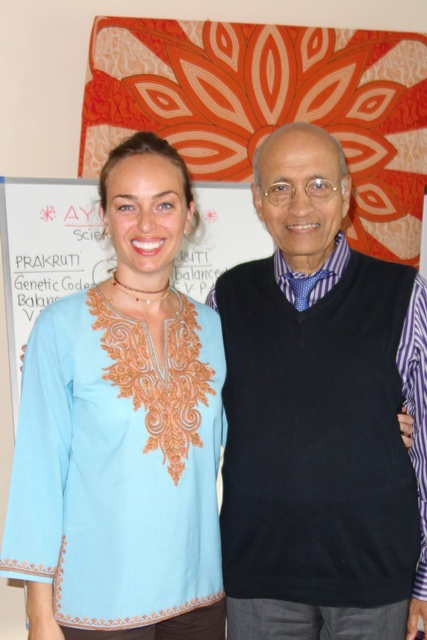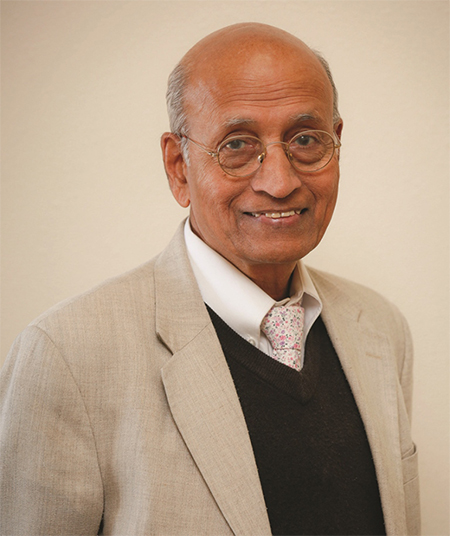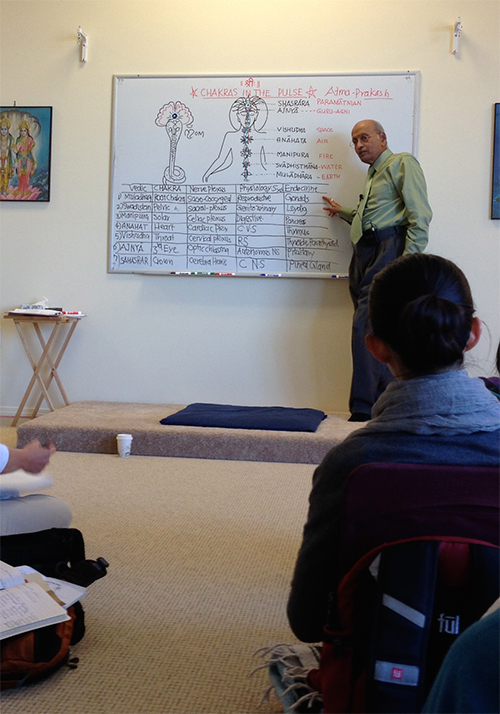
I could hardly believe my eyes when I met Dr. Vasant Lad. He is a person of distinction as the living legend of Ayurveda Medicine, whisperingly rumored to be a saint, the sole author of Ayurvedic Medicine books from A to Z and a master in the full sense of the word. And for two days I would be part of a small group of 20 people who would be taking lessons in his presence. To me, this was kind of a miracle.
I had the privilege of being personally instructed first by Dr. Deepak Chopra and then Dr. Vasant Lad, both of whom are revered as the most knowledgeable and competent people around the world in the discipline of Ayurveda... Lucky me. In a sense, the spiritual order was laying the way open for me to become a good Ayurveda specialist...
When I look back on my life, I can say that I was vouchsafed to get to know two people whose eyes mirrored absolute Divine Love and Divine Light. Sure enough, one of them is Dr. Lad. He is the wisest, the most modest and tenderhearted person I have ever met. When you look into his eyes, you are pulled into such a depth that it is impossible not to feel that sublime feeling of mercy.
Dr. Lad spreads his wisdom by means of very strong vibrations of compassion and love... I am honored to make you meet on these pages. I hope his advice will shed light on your life, for it already did on mine...
1. Your guru, who taught you when you were a child, prophesied that you would go to the United States of America to introduce the perfect system of Ayurvedic medicine, which is the gift to humanity, to the western world. Could you please share this memory of yours with us?
My guru was my father’s guru.
My father used to wake up early each morning and do pranayama and meditation. When he would sit for meditation, in a cross-legged posture, there was absolute silence. People would whisper and walk slowly, so there was no sound from their feet. That was the impact of the peace that was coming from his meditation.
Every day he would sit for his meditation and there was a very beautiful atmosphere. So one day I asked my Dad, “What are you doing?” He said, “I am doing dhyana.” Dhyana means meditation. Then I asked, “Anybody can do it?” He said, “Yes!” I said, “Can I learn from you?” and he said, “No, I am not authorized to teach you, but my guru comes here the first day of each month for three days. During those three days, whoever comes to him, he initiates them and gives each a mantra and meditation. Immediately, I said, “Can I get that mantra and meditation?” He said, “You will have to wait until next month.”
I was maybe 9 or 10 years old, so I eagerly waited for his next visit. I continued my school, going and learning, but in the corner of my mind there was this constant waiting for the guru. On that day, the first of the next month, when he came to our town, I asked, “Dad, your guru has come?” He said, “Yes, and he is going to discourse on the Baghavad Gita. Would you like to come?” I went with my father and that’s a very interesting story. I sat right in the first row. It was a very small room, something like 10 x 20 feet, and there were maybe 60 people there. That room was completely packed! A man in his mid-70’s came. I was certain that the guru would have a long beard, matted hair, and some dhuti and rudraksha(1); that was my picture. I couldn’t see anybody that looked like that. There was just a simple, ordinary old man sitting on the platform. I whispered in my Dad’s ear, “Where is your guru?” He said, “That person is my guru!” “Oh, he looks like an ordinary man, anybody’s grandpa.” He said, “Wait. Listen to him.” And then the guru started giving a talk about the Bhagavad Gita. He was talking about yoga, and the types of yoga: Karma, jnana and bhakti. As he spoke, he was looking directly at me and I was looking directly at him; there was eye-to-eye contact as if he was talking only to me. He spoke for about one and a half hours. He totally blew my mind. I lost my sleep. For the whole night he was in my dreams, talking and talking.
The first day I listened, the next day I listened, and the next. Then I said to him, “I want initiation from you.” And he said, “Right here.” He whispered a mantra in my ear. Then he put his hand on my forehead and I felt the electrification and energy. And he said, “Oh, you will be a very good Ayurvedic student and teacher, and you will go abroad, to England, America and Germany. You will write books and you will teach people about Ayurveda.” I was completely surprised. I said, “I don’t even know English!” He said, “You don’t have to do anything. Just close your eyes and do your prayers and things will happen.” And really, that happened.
That was a profoundly beautiful experience of my childhood. I think that it is the mission of that divine master for me to come to the western world and start teaching Ayurveda, writing books and articles, and traveling and giving lectures, seminars and webinars. The inspiration and energy comes from that source. That’s why I always say it is the ‘speaker’; it is not me, it is his blessing.
(1) Dhuti (often spelled dhoti) is a long loincloth worn by many Hindu men in India and rudraksha is a seed traditionally used for prayer beads in Hinduism.

2. In 1978 you came to the US and started to promote Ayurveda, while also serving in the field. When you first moved to the United States, you come to New Mexico, which is currently the home of the Ayurvedic Institute. What were the hardships that challenged you the most when you first started?
In the 1970s, a gentleman named Lenny Blank came to Pune.
He actually came to inquire about Robert Svoboda, who was a student at that time, but Robert was not there. So I introduced myself and offered him a cup of chai and some poha and we started talking. We became quite good friends and he would attend my lectures. I was a professor of Ayurvedic Clinical Medicine and the Chief Medical Officer, which they call Medical Director, of the hospital. He used to come to my clinic and attend my lectures; he was totally spellbound. He said, “Dr. Lad, this knowledge is very important. If you come to America, people there will love it.”
I said, “They are so advanced scientifically. They have gone to the Moon and put the American flag on the Moon. I have much love and respect for America, but they are quite advanced in modern science and Ayurveda is a 5,000 year-old science that must seem outdated. Why will they welcome me?” He said, “No, you don’t understand. This is beautiful. People will like it. They need this knowledge.” And he was right. He sent me my plane ticket and I went to New York and stayed with him in a tiny apartment on East 11th Street. I would teach seminars there. Then we started traveling. From New York, we went to Chicago and Houston and then to New Mexico.
We were driving in his car; a small Volkswagen that was like a little, white bug. I would sit in the back, and he and his girlfriend were in the front. I would sleep there in that tiny car. I saw all the seasons from the back seat of that car. In Santa Fe, we visited the Santa Fe College of Natural Medicine. Dr Scott and Vivian were running the school. He liked Ayurveda and we became very close friends. His wife was a loving lady and wanted me to teach there. I did some seminars, but I was homesick. I told them I should go back to India, but they said, “Stay here and we will sponsor you.” They sponsored me and I began to teach regularly in their school. They had 200 students and the school was flourishing but it eventually closed. Then I began teaching at the Institute of Traditional Medicine (ITM). In the evenings, people in the neighborhood would come to me for a consultation. I would treat them with simple herbs, such as cinnamon, cardamom, and turmeric and I became somewhat famous in Santa Fe. I even had clients coming from Albuquerque.
Over time, I realized that I was homesick and wanted to go back home. I was alone here, without my family. Additionally, Santa Fe was very cold, being more than 7,000 feet above sea level. I was very nervous and anxious, so my family came over. My children were small and it was still cold in Santa Fe. Then ITM closed and I interpreted that as a message to start my own school. Because Santa Fe is at such a high altitude and people feel breathless there, there was much discussion about where to locate the school. Then Jim Skilling, a dear friend who lived in Bernalillo, said, “Dr. Lad, you have started your foundation here in New Mexico. You should move to Albuquerque. It is 10 degrees warmer than Santa Fe and the airport is close.” That was becoming quite important, because every weekend I would fly to another city to give a seminar or workshop. Because of these considerations, we ended up in Albuquerque and The Ayurvedic Institute was established here.
When I first came to America, it was a culture shock. In those days, there were no Indian grocery stores, so no Indian spices or Indian foods were available. We had to manage by going to the co-op and buying whole wheat flour and cinnamon, cardamom and so forth. Usha used to make chapatis and people loved them. In this way we started our journey and, although it was difficult in the beginning, with the grace of God and the grace of people’s love, the Ayurvedic Institute was established in Albuquerque, New Mexico.

3. When you are doing an Ayurvedic Consultation, you always ask the birth date of the patient, and like to check their astrological map. Is this a precise system? What kind of information does Vedic Astrology reveal about the patient? And, to what extent can the positive or negative potentials in a patient’s astrological chart be steered or directed?
You know moment I look at the pulse, I look at the body frame, body shape, expression, facial expression and that tells me what is their prakruti.
Then when I ask the date of the birth, I know their astrological sign. Then I map that and realize this person is tall so he likely has Saturn in Capricorn or Aquarius in the first house, and it is there! Or when a person is strong pitta, he likely has Scorpio with the Mars. Astrology says the first house ascendant represents prakruti and sixth house is vikruti. Just by reading the pulse, I know their prakruti and vikruti and I confirm that with their astrology chart. Because astrology and Ayurveda are concurrent and inherent, they go together.
When I see person who has retrograde Jupiter in the fourth house, that woman will likely get breast cancer in the right breast. When Jupiter is in the 4th house, that indicates the right breast. When Jupiter retrograde is in the 10th house, that is left breast. Retrograde Jupiter indicates abnormal tissue growth, a tumor or lump, or fibrocystic changes. Mars and Saturn together indicates hypertension, cardiovascular disorder and heart attack. In the fourth house, when Saturn is with Mars that person may have high blood pressure, cardiovascular disorder and will likely have a heart attack. This is how, astrologically, I can tell what will happen in the future.
There are certain diseases associated with each of the planets. For instance, someone with Jupiter in the ascendant may get hypothyroidism, obesity, diabetes and hypertension. Saturn can create neuromuscular disorders, scoliosis, kyphosis, arthritis, rheumatism, sciatica and even tuberculosis. Mars is a hot planet, so it can create peptic ulcer, ulcerative colitis, Crohn’s disease, regional ileitis and so forth, depending upon where in the chart it is placed.
Astrology and Ayurveda help each other, both diagnostically and in terms of prognosis. For example, if Mars and Saturn are together in the eighth house, that person may get stroke paralysis. So we can see that if a patient is diabetic and hypertensive and Mars and Saturn are in their eighth house, I can say, “Look, there is a possibility of cerebrovascular accident, in which case you will likely get a heart attack or stroke paralysis.”
That’s why I ask the date and time of birth, and the place of birth. Astrology really helps with prognosis, diagnosis and with therapeutic assessment. The person’s birth nakshatra (constellation) is associated with certain herbs, so by knowing the individual’s prakruti and vikruti and their nakshatra, we can determine a dosha pratyanika (specific to the dosha), dhatu pratyanika (specific to the tissue), vaya prantyanika (specific to samprapti), and organ pratyanika (specific to the organ). For instance, if I look at the chart and that person’s Moon is in Punarvasu, then he should have punarnava. Punarnava is then astrologically based for the person’s astral body. That way an Ayurveda consultation and Jyotisha consultation can go together.
Continue